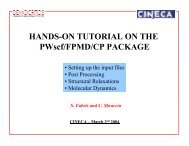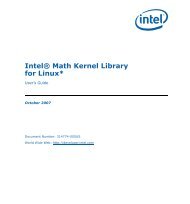Notes on pseudopotential generation
Notes on pseudopotential generation
Notes on pseudopotential generation
Create successful ePaper yourself
Turn your PDF publications into a flip-book with our unique Google optimized e-Paper software.
is no orthog<strong>on</strong>alizati<strong>on</strong> to core states. As a c<strong>on</strong>sequence a PP should have projectors<br />
<strong>on</strong> angular momenta up to l c and l = l c + 1 should be the local reference state for PW<br />
calculati<strong>on</strong>s. This rule is not very strict and may be relaxed: high angular momenta<br />
are seldom important (but be careful if they are). Moreover separable PP pose serious<br />
c<strong>on</strong>straints <strong>on</strong> local reference l (see below) and the choice is sometimes obliged. Note<br />
also that the highest the l in the PP, the more expensive the PW calculati<strong>on</strong>.<br />
NOTE 2: a completely empty c<strong>on</strong>figurati<strong>on</strong> (s 0 p 0 d 0 ) or a c<strong>on</strong>figurati<strong>on</strong> with fracti<strong>on</strong>al<br />
occupati<strong>on</strong> numbers are both perfectly acceptable. Even if fracti<strong>on</strong>al occupati<strong>on</strong><br />
numbers do not corresp<strong>on</strong>d to a physical state, they corresp<strong>on</strong>d to a perfectly defined<br />
mathematical object.<br />
NOTE 3: in the TM approach you generate the PP for every l <strong>on</strong> the valence state<br />
of lowest main quantum number n. If there are states with the same l and higher n,<br />
they MUST BE EMPTY.<br />
NOTE 4: PP could in principle be generated <strong>on</strong> a spin-polarized c<strong>on</strong>figurati<strong>on</strong>,<br />
but a spin-unpolarized <strong>on</strong>e is typically used. Since PP are c<strong>on</strong>structed to be transferrable,<br />
they can describe spin-polarized c<strong>on</strong>figurati<strong>on</strong>s as well. The ”core correcti<strong>on</strong>”<br />
is typically needed if you plane to use PP in spin-polarized (magnetic) systems. In any<br />
event: the atomic code presently does not perform true spin-polarized calculati<strong>on</strong>s. It<br />
can calculate the energy perturbatively: up and down orbitals are the same, the total<br />
energy is calculated using a spin-polarized functi<strong>on</strong>al, assuming Hund’s rule for spin<br />
occupati<strong>on</strong>s. As a matter of fact, the energy calculated in this way is quite a good<br />
approximati<strong>on</strong>.<br />
3.4 Generating all-electr<strong>on</strong> results<br />
You may now generate all-electr<strong>on</strong> (AE) wavefuncti<strong>on</strong>s and <strong>on</strong>e-electr<strong>on</strong> levels for the<br />
reference c<strong>on</strong>figurati<strong>on</strong>. This is d<strong>on</strong>e by using program ld1. You must specify in<br />
the input data: atomic symbol, what you chose as density functi<strong>on</strong>al (not needed if<br />
you stick to LDA), the name of a wavefuncti<strong>on</strong> file, electr<strong>on</strong>ic reference c<strong>on</strong>figurati<strong>on</strong>.<br />
A complete descripti<strong>on</strong> of the input is in the header of file Src/ld1.f. If you want<br />
accurate AE results for heavy atoms, you may want to specify a denser grid in r-space<br />
than the default <strong>on</strong>e. The defaults <strong>on</strong>e should be good enough for PP generati<strong>on</strong>,<br />
though.<br />
Before you proceed, it is a good idea to verify that the atomic data you just produced<br />
actually make sense. Some kind souls have posted <strong>on</strong> the web a complete set of reference<br />
atomic data :<br />
http://physics.nist.gov/PhysRefData/DFTdata/<br />
These data have been obtained with the Vosko-Wilk-Nusair functi<strong>on</strong>al, that is very<br />
similar (at least for the unpolarized case) to the Perdew-Zunger functi<strong>on</strong>al. You may<br />
want to have a look at them.<br />
3.5 Choosing the matching radii<br />
At the matching radius r c the AE and PP wavefuncti<strong>on</strong> of angular momentum l match,<br />
with at least c<strong>on</strong>tinuous first derivative. The choice of the r c is very important and<br />
must be guided by the following criteria:








